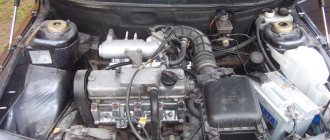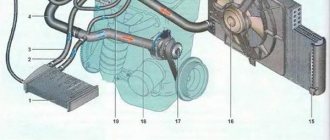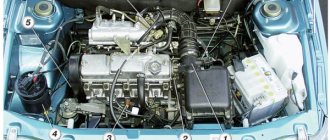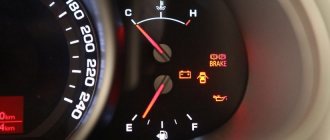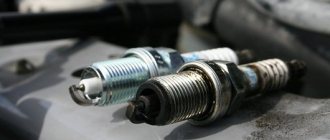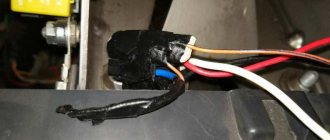Causes of engine overheating
The temperature indicator needle has entered the red zone, which means the engine is overheating
Many car enthusiasts remember the reasons for the effect on old Zhiguli cars. On 16-valve engines, the reasons for this effect are almost the same. Let's consider what reasons may cause the main power unit to begin to overheat:
- The system is clogged.
- Thermostat stuck.
- Damage to the pump. Replace the pump. About choosing a pump for a 16 valve engine here.
- Radiator.
- Cooling sensor malfunction.
- The cooling fan does not operate (see “fan relay).”
All these problems can cause the engine to overheat.
Elimination methods
To eliminate the causes of engine heating, it is necessary to establish the epicenter of the effect. To do this, it is worth checking each node sequentially. After identifying the problem, it is worth finding the exact cause and eliminating it. So, let's consider the sequence of actions.
Engine cooling system diagram
Radiator and pipes
One of the reasons for engine overheating may be that the radiator and pipes become clogged, which affects the circulation of fluid in the system, and can also lead to cracks in the pipes and breakdown of the radiator, which will lead to leakage of coolant.
If there is insufficient coolant in the system, the power unit will heat up faster and take a long time to cool down, and the cooling fan will run almost continuously.
Radiator and cooling system pipes
The method for solving the problem is quite simple - dismantling the radiator from the system and cleaning it both outside and inside.
The second stage will be to inspect the pipes for leaks and replace worn-out products. As practice shows, many motorists install kit kits (tuning versions) of the radiator and pipes to extend the service life of the cooling system.
Pump (water pump)
One of the main reasons for overheating is that there is play in the water pump. It is quite easy to determine this malfunction, because a corresponding howl appears in the pump area. Also, a sign of a malfunction may be that liquid begins to leak from the pump shaft. The problem can be fixed quite easily by replacing the water pump.
Engine mounted water pump
Thermostat
The thermostat is the first place to look for a problem.
Every 50 thousand kilometers, it is recommended to change it, but this factor is not all true, since the performance of the part is influenced by factors such as the condition of the coolant, the quality of the installed part, etc.
So, when the thermostat is stuck on a small circle, the engine heats up more often than usual, even when driving on the highway, where there is enough oncoming air flow for the system to have time to cool itself.
Thermostat removed from the engine
There is one caveat when the thermostat should not be changed - if it fails in winter. Then, additional cooling is provided by sub-zero temperatures. Of course, if the thermostat fails in the summer, then to prevent overheating of the motor, it must be replaced as soon as possible.
Cooling sensor
The cooling temperature sensor is a harmless breakdown that can lead to the indicator on the instrument panel showing incorrect data, so the driver will not even know that the engine has overheated until it boils on the road.
Typically, this malfunction is accompanied by many associated factors, so it is quite difficult to miss it. There is only one solution to the problem - replacing the cooling system sensor and resetting errors that occurred in the ECU.
Cooling sensor
Fan
The last cause of overheating, especially in the summer, is the cooling system fan.
The fan under the hood is indicated by an arrow
So, a breakdown of this unit can cause the engine to overheat and the coolant in the expansion tank to boil.
In this case, the consequences can be very diverse, well, you need to check the fan for serviceability, as well as the sensor for turning it on - that’s for sure. This part fails quite rarely, and therefore the reason for the failure may be a simple fuse or a wiring fault, which can be easily fixed.
Consequences of untimely elimination of defects
Not all drivers realize what consequences can be caused by an engine overheating, and continue to drive with a constantly running fan or frequent overheating.
So, the consequences of strong engine heating are divided into 3 stages, which are worth considering separately.
Slight overheating
If the engine overheats for up to 10 minutes, the consequences may be minor. Thus, cracks will appear in the pipes of the cooling system, the temperature sensor will fail, the oil scraper rings will become deformed, and the valve and camshaft seals will melt. Also, the valves will burn out, and oil will enter the combustion chambers, which will be marked by the release of black smoke from the exhaust system.
Consequences of mild overheating, namely burnout of valves
Significant overheating
With significant overheating, deformation occurs, or rather deflection of the cylinder head. To eliminate these consequences, you will have to dismantle the cylinder head and submit it for surface grinding. Thus, it turns out that the block head is subject to major repairs.
Burnout of the piston group due to significant overheating
Measuring the deflection of the cylinder head using a ruler
conclusions
The causes of heating and overheating of a 16-valve engine have been identified and elimination methods have been discussed. Thus, untimely repair of this unit can lead to the fact that the engine will finally fail and will need to be replaced. Therefore, if the first signs appear that the cooling system has failed, it is necessary to find and eliminate the cause, since a replacement will be much more expensive.
Overheating of a car engine is a problem that every driver may encounter. In this article we can find out:
- how to notice in time that the engine has overheated;
- why the engine gets hot in general and in certain situations;
- what to do if the engine overheats.
To understand the essence of the issue, it is necessary to consistently read all the explanations of an experienced auto mechanic.
Reasons for long engine warm-up
- The ambient temperature is too low and, as a result, the coolant temperature in the radiator is too low. The easiest way out of this situation is to insulate the radiator, engine compartment, hood and engine. Ordinary plywood or cardboard inserted in front of the radiator very quickly and effectively solves the problem of engine cooling while driving. As for the car blanket and hood insulation, with this solution a cold engine will warm up faster and reach operating temperatures.
- Thermostat is not working properly. For those who do not know or simply forgot, it is worth recalling that this part is responsible for directing the flow of coolant along the large or small cooling circle. The small circle prevents antifreeze or antifreeze from entering the radiator and ensures its circulation only inside the engine. As a result, the motor heats up faster.
Only after heating the liquid to a certain temperature does the thermostat work and release antifreeze through the radiator for better cooling. In turn, antifreeze not only performs the function of cooling the engine during operation, but also maintains the set operating temperature of the unit.
A constantly open thermostat prevents antifreeze from reaching the required temperature in winter. This is why the engine takes a long time to warm up at this time of year. Solution: repair or replace the thermostat.
- Air lock in the cooling system. As with any heating system, air interferes with the normal passage of fluid. In this case, it is necessary to determine the cause of the traffic jam and eliminate it.
- A less common cause of long warm-up may be a feature of the factory settings of the car’s electronic control unit (firmware) or their incorrect settings during flashing (chip tuning). One of the easiest solutions is to install an additional on-board computer with a function for adjusting the fan temperature.
- Premature operation of the cooling system fan can also lead to long warm-up times. It happens that the specified fan turns on even after starting a cold engine.
What to do if your car overheats in a traffic jam
When driving a car for a long time in a lower gear, the engine operates with increased power, which in itself leads to overheating. Add to this the lack of oncoming air flow necessary to cool the radiator. What to do?
The main thing is not to panic. Short-term overheating is not terrible, but if you see that the car is not cooling down, it’s time to act.
- Important - do not turn off the engine unless absolutely necessary. Exactly - without extreme. A stalled, overheated engine is an almost 100% guarantee of repair. It will take quite a long time to describe what is happening in the engine in this case (rotating the liners together with the crankshaft, when the engine is subsequently started - the least of the possible troubles), just take it on faith.
- Important - do not think about pouring water on the engine or pouring cold water into the radiator. The result is the same - repair. Moreover, you can try so hard that you cannot do without replacing the block and cylinder head. Another “beauty” of cold water is microcracks inside the block. Finding and eliminating will be very, very difficult, if not impossible. The car has overheated - try to pull over to the side of the road. If it doesn’t work out, don’t panic and don’t pay attention to those around you – it’s important for you to save the engine.
- Stop at idle, turn the heater on full, and wait. If after 5-10 minutes the situation does not improve, turn off the engine. It’s a good idea to open the hood; the main thing in a panic is not to forget to set the car’s parking brake.
- The only reason to turn off the engine right away is clouds of steam coming from under the hood. Most likely, the cooling pipe has burst, and further operation of the engine will only worsen the situation.
This is what it looks like, engine overheating, if you look closely. Now you know why the engine gets hot and how to deal with it.
Consequences of untimely elimination of defects
Not all drivers realize the consequences of engine overheating and continue driving with a constantly running fan or frequent overheating. Thus, the consequences of strong engine heating are divided into 3 stages, which should be considered separately.
Slight overheating
If the engine overheats for up to 10 minutes, the consequences may be minor. Thus, cracks will appear in the pipes of the cooling system, the temperature sensor will fail, the oil scraper rings will be deformed, the valve seals and the camshaft will melt. Additionally, the valves burn out and oil enters the combustion chambers, which will be indicated by the release of black smoke from the exhaust system.
Consequences of slight overheating, namely valve burnout.
Significant overheating
With significant overheating, deformation occurs, or rather deflection of the cylinder head. To eliminate these consequences, you will need to disassemble the cylinder head and give it a groove on the surface. Thus, it turns out that the block head needs to be modified.
Burnout of the piston assembly due to significant overheating Measuring the cylinder head deflection using a ruler
Severe overheating
With severe overheating, the walls of the cylinder block are deformed and burnt, which causes the piston assembly to melt, the connecting rods to become deformed, or even the crankshaft to break. Consequently, the engine cannot be repaired, since usually the walls of the power unit are destroyed and their restoration is impossible.
Burnout and deformation of pistons after severe overheating Melting of the walls of the cylinder block after overheating
How to fix the problem
The logical solution to the problem, in this case, is to replace either the thermostat itself or the component thermoelement. Both options are quite cheap, since we are talking about a domestic manufacturer, there is no need to buy any analogues. This procedure can easily be carried out independently, but if you do not know the technical component of the VAZ-2110, it is still better to contact specialists at service stations. The most important thing is to first drain all the antifreeze in the system.
As a result of the replacement, the car’s instrument scale should show an engine temperature of at least 90 degrees after 20-30 minutes of warming up or 10-15 minutes of driving without prior waiting. The thermostat scale must be monitored periodically, at least once every 15 minutes of travel. A quick glance is enough to ensure that the engine temperature is within the required range, which will automatically indicate the integrity and suitability of the thermostat itself.
Long warm-up can also be a consequence of incorrectly selected antifreeze for the cooling system, but such cases, as practice shows, are rare.
Checking the position of the engine thermostat
If the thermostat is installed correctly, it is able to close the valve quickly. The cooling system works properly and the engine does not overcook. To check the device, visual inspection is most often used.
A specialist in a car service assesses the condition of the upper pipe. If plaque is visible on it, it must be replaced. There is also equipment for testing. It makes it easy to measure the capacity inside the tank.
Long engine warm-up on a VAZ-2110 with 16 valves
The reason that the temperature of the internal combustion engine remains the same, despite a fairly large amount of time spent on warming up, in most cases lies in a malfunction of the thermostat. In such cases, one of its valves gets stuck due to a defect and does not change position even after the ignition is turned on. Thus, the circulation of the working cooling fluid will always occur in a large circle, preventing the engine from reaching the optimal operating temperature
It may seem to some that this is not a problem at all, especially in the summer, since the lower the temperature of the internal combustion engine, the more the risk of overheating and failure is eliminated. However, precisely because the operating temperature range has not been reached, all propulsion systems do not operate efficiently enough. Sharp acceleration in such cases is unacceptable - wear of parts at low temperatures increases many times over. In addition, the interior of the VAZ-2110, the thermal insulation of which deserves far from the most flattering words, needs to be thoroughly warmed up, especially when it comes to winter use. And if the thermostat malfunctions, the air emanating from the dampers simply will not heat up, and passengers will have to put up with discomfort throughout the entire trip.
Instructions for replacing the engine thermostat
To replace the engine thermostat if it gets hot, if the engine gets hot, it's best to follow the instructions. Let's look at the replacement process using the VAZ 2114 as an example:
- Turn on the radiator tap.
- Removing the cover.
- Checking the tank.
- Antifreeze drain.
- Replacing the clamp.
- Sensor evaluation.
- Disconnecting the box.
- Inspect the air filter.
- Replacing the thermostat.
The most difficult thing in a VAZ-2114 Lada car is to get to the clamp. To unscrew all fasteners, you will need a hexagon. The pipes are sometimes stationary, so they must be replaced immediately. When evaluating a spring, you need to make sure that there is a layer of sealant.
The seat for the part should not be heavily cleaned. When using sealant, the likelihood of clogging the throttle assembly increases. When coolant is leaking, it is better to check the expansion tank.
This can only be done after disconnecting the pipe. If you ignore malfunctions of the throttle assembly, there is a high probability of an air lock. This will cause the engine to heat up.
How to determine if the engine is overheated
At first glance it seems very simple - according to the indicators of the engine temperature device, or - sensor. This is true, if not for one thing - novice motorists are so captivated by the road situation around them that they look at the instrument panel only in one case - how much fuel is left. Experienced motorists, on the contrary, due to their confidence in their abilities, also do not look at the car’s dashboard. And as a result, a situation often arises that overheating is detected when the engine temperature has long exceeded permissible limits, and irreparable damage has been caused to the engine. It is irreparable overheating that is one of the most complex malfunctions, which leads to very serious consequences. But more on that later. But there is a way that will not let you miss the moment of overheating. This is problematic in a traffic jam, and is not always clearly present, but here’s what you should be aware of:
— As soon as the engine temperature exceeds the permissible norm, when you sharply press the gas pedal, or when accelerating the car, even slightly, detonation knocks are clearly heard, which are popularly called “tapping fingers.” This is not true, but everyone knows this definition. If you hear such a sound, there is a 99% chance that the engine has overheated, and action must be taken.
Detonation knock is a loud metallic knock, the frequency of which coincides with the engine speed. You've probably heard such sounds when refueling with low-quality fuel. I personally don’t know where the concept of “tapping fingers” came from. But the real reason for such knocking noises is a disruption in the fuel combustion process. What you hear is nothing more than explosions of the fuel mixture. During normal engine operation, the combustion process is controlled, but as soon as one of the operating parameters is violated, the process goes out of control and combustion turns into an explosion. Hence the concept - detonation (from the word detonate - explode) knocks. When the engine overheats, this is the first sign.
Before continuing the conversation, let's define what is normal temperature and what is overheating. There is no one-word answer, but there are general rules. The engine temperature is within 85-95 degrees Celsius, which is working. Engine temperature up to 100 degrees is acceptable. This means that a short-term increase in temperature to 100, sometimes up to 105 degrees is allowed. Just for a short time - up to 5 minutes. Engine temperature above 105 degrees Celsius means overheating and action must be taken.
What to do if the VAZ-2110 engine takes a long time to warm up
Cars from domestic manufacturers have always had plenty of problems. Yes, in the early and mid-80s of the last century, the Russian automobile company AvtoVAZ made a splash with its technologically equipped and affordable copies - and nothing has changed since then. True, nothing has changed in the bad sense of the word.
The same technologies are used: low-power, albeit high-resource engines, primitive design and interior, low-quality interior materials, unpleasantly surprising safety test results. And this is not to mention the fact that the list of problems remains the same, despite the fact that every few years each model range undergoes a deep restyling. And this, for a second, is in 2022. In fact, the VAZ is only suitable as a means of transportation “from point A to point B”, because comfortable movements on it are completely excluded.
Thematic forums are constantly replenished with new problems of the so-called pelvis valves: either the turn signals stopped turning on, or the stove broke for no reason, or even you can’t go anywhere with your iron friend - it doesn’t want to start.
Long engine warm-up on VAZ-2110 (16 valves)
The reason that the temperature of the internal combustion engine remains the same, despite a fairly large amount of time spent on warming up, in most cases lies in a malfunction of the thermostat. In such cases, one of its valves gets stuck due to a defect and does not change position even after the ignition is turned on. Thus, the circulation of the working cooling fluid will always occur in a large circle, preventing the engine from reaching the optimal operating temperature.
It may seem to some that this is not a problem at all, especially in the summer, since the lower the temperature of the internal combustion engine, the more the risk of overheating and failure is eliminated. However, precisely because the operating temperature range has not been reached, all propulsion systems do not operate efficiently enough. Sharp acceleration in such cases is unacceptable - wear of parts at low temperatures increases many times over. In addition, the interior of the VAZ-2110, the thermal insulation of which deserves far from the most flattering words, needs to be thoroughly warmed up, especially when it comes to winter use. And if the thermostat malfunctions, the air emanating from the dampers simply will not heat up, and passengers will have to put up with discomfort throughout the entire trip.
Choosing the right thermostat for your engine
There are large manufacturers on the market:
- Luzar.
- Master.
- Kraft.
Thermostats vary in cost and quality. When selecting, you need to pay attention to the following factors:
- quality of pipes;
- rod length;
- valve operation;
- return spring diameter;
- strength of the bottom frame.
Driver signals
A specially equipped sensor in each car will help to systematically monitor or control the temperature of the fluid in the cooling system at the current time. In more modern cars, it can be slightly modified and reflect the indicators using LEDs, but the essence does not change, the goal remains the same - to help the driver communicate the readings.
If you blink and aim the gauge in the red zone, expect a plume of steam to shoot out from under your friend's hood in a matter of seconds. Believe me, there is nothing good here, and no one knows how it might end.
The concept and principle of operation of a thermostat
Now about the physical side of the “medal”. We also know from driving school that the cooling system of a car consists of large and small circles through which either liquid or water circulates. When the engine starts and up to 90°C the fluid flows in a small circle, from 90°C up the thermostat opens and starts flowing in a large circle to reduce the overall temperature by lengthening the flow chain.
As a result, malfunctions of the thermostat can lead to its failure to open in a timely manner and the coolant to boiling. So expect a “hello” from the piston rings.
You can check the operation of the thermostat as follows:
Start and warm up the engine to 90 ° C and feel the radiator hose, if it is hot, the thermostat works, otherwise urgently look for a replacement. If it happens that the thermostat fails, we buy its useful analogue at any car dealership or on the market and prepare to replace it ourselves.
Full diagnostics
To exclude incorrect operation of other components in the car, it is necessary to do a complete diagnosis of the thermostat.
Set of events:
- checking the pipe;
- radiator assessment;
- measurements with a thermometer.
When diagnosing, it is important to take a control temperature measurement. The workshop monitors the moment the valve operates. According to the manual, there are differences between cars of different series. In normal condition, the stroke of the rod is at least 5 mm.
